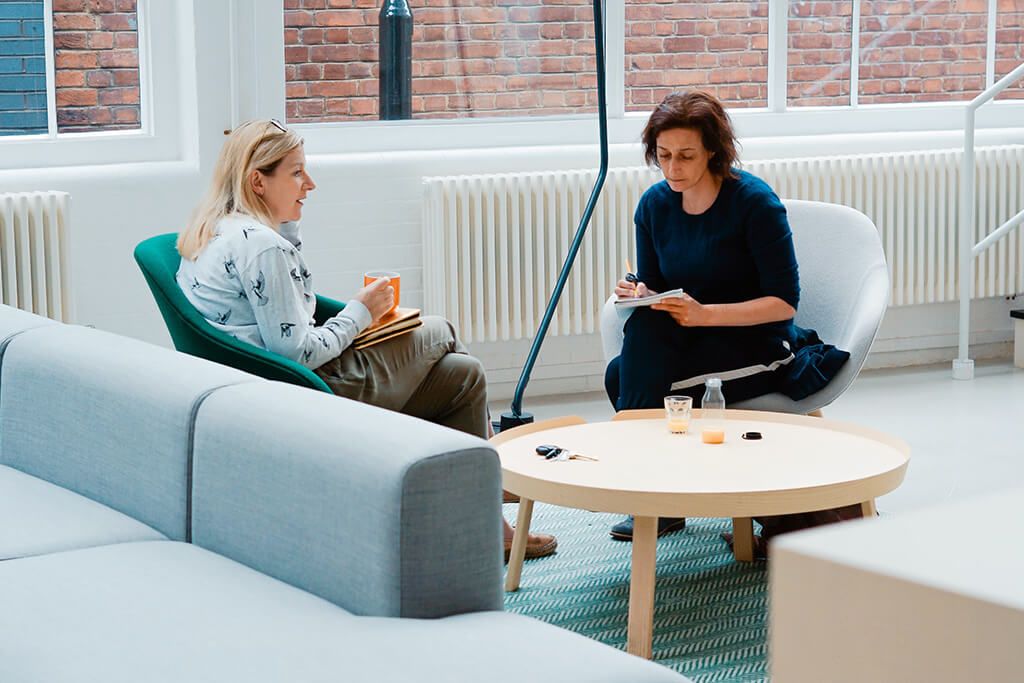Insights
Cosy nooks and AR displays: How to create empowering workspaces
Author
Lucy Clayton
Business Thought Leadership
Virgin Media O2 Business
7 minutes
05th April 2022
Share this article:
Lucy Clayton, Business Thought Leadership at Virgin Media O2 Business, looks at the evolving role of the workspace — both physical and virtual — in empowering employees to do their best work.
Ask your employees about what they like most about home working, and you’ll likely get a variety of responses. The chance to give the kids a goodnight kiss1, take the dog for a walk2 or go for a daytime run3 – all of these emerged as some upsides of pandemic home working.
At Spotify, another unexpected benefit gave the audio streaming giant pause for thought. “In our homes we've got really good acoustics; we've got sofas and curtains,” Sonya Simmonds, Spotify’s head of workspace design and build, said in an online talk4 organised by design magazine Dezeen. And that's what's lacking in an office sometimes.
“In our homes we've got really good acoustics; we've got sofas and curtains. And that's what's lacking in an office sometimes.”
– Sonya Simmonds, Head of Workspace Design and Build, Spotify4
That realisation has sparked a new approach to office design at Spotify. “What we've learned is this cosiness, we want to keep that,” said Simmonds. To make its offices feel like the best aspects of home working, Spotify is introducing features like personalised music, “cosy little nooks” with soft furnishings, and desks facing a window.
And it’s not the only one: Lego Group has also rethought its office space to better meet its employees’ needs. As journalist Anna Whitehouse noted on The New Everyday podcast5, the top floor of its London office is now dedicated to creative work, the middle floor to meetings and collaboration, and the bottom floor to quiet work. “You can choose the ‘why’ of your day,” she said.
Three ways to rethink workspaces for an improved employee experience
Spotify and the Lego Group both embody the belief that the right environment is critical for employees to be at their best, whether the space is physical or virtual, customer-facing or internal, in a company building or outside.
The right environment is important not just for employee retention, but given the link between the employee experience and the customer experience, also for customer loyalty.
Today, the companies most focused on improving their employee experience are re-thinking spaces in three ways, with technology playing a vital role in all three:
- Optimising physical premises for engaged and agile working
- Supporting remote work with equipment, technology and tools
- Creating virtual spaces geared to seamless collaboration
1. Optimising physical premises for engaged and agile working
As many people return to the office for at least part of the week, many companies are re-assessing the purpose of the office in a dynamic working world and adapting their physical space accordingly.
PwC, for example, found that 87% of executives it questioned for its 2021 remote work survey6 were planning to make changes to their organisation’s real estate strategy – noting that “some companies are planning to reinvest the remote work dividend in new ways in order to create a special experience in the office.”
“Companies are planning to re-invest the remote work dividend in new ways in order to create a special experience in the office.”
– PwC, US Remote Work Survey, 20216
Furniture, lighting and layout are all key considerations in the new-style office, as are new “smart workplace” technologies – from indoor location intelligence7 to understand how space is used, to hybrid conferencing tools, like Zoom’s Smart Gallery8, that allow remote and physically present workers to collaborate effectively.
And it’s not just big companies that are re-imagining their offices for a better employee experience. Dave Cairns, Senior Vice President for Office Leasing at CBRE, told the O2 Blue Door podcast: “I am seeing certain smaller companies and start-ups doing really fascinating things. They are building workplaces that are really geared around activity-based forms of working, rather than around sitting at a desk and typing emails. And so those workplaces are smaller and far more agile.”
2. Supporting remote working with equipment, technology and tools
One of the great inequalities of pandemic home working was the workspace disparity between senior employees and those who were starting their careers. While senior-level staff were more likely to be among the 47% of home workers with dedicated home offices9, their junior colleagues were often left vying for space – and connectivity – in shared accommodation.
For Millennials and Gen Z, the stress of pandemic home working is one of the drivers behind the Great Resignation10, which in November 2021 saw almost one in four UK workers11 planning a job change. It’s a wake-up call to employers to better understand and address employees’ spatial and equipment needs when working remotely.
Our own experience at Virgin Media O2 tells us that whether they’re working from home or a local café, employees need a safe, comfortable and well-equipped environment to do their best work. For employers, that means ensuring the right tech is available wherever they choose to work, including adequate connectivity, secure access to relevant systems, and task-appropriate devices.
Support for home working may also involve allocating budget for ergonomic task chairs and height-adjustable desks, in line with health and safety policies. Shopify and Twitter are just two of many companies that now offer employees an allowance to kit out their home office12.
During the pandemic, Shopify and Twitter offered newly-remote workers $1,000 to set up an ergonomic home office.12
Meanwhile, corporate membership of co-working hubs can enable employees to work closer to home, reducing the inefficiency of long commutes while providing a dedicated working environment with opportunities to socialise.
3. Creating virtual spaces geared to seamless collaboration
A lot of remote engagement with customers and colleagues still takes place via laptop, desktop, tablet and phone screens. But new options are also emerging that can further close the gap between physical and virtual. As head-mounted displays get smaller and lighter, there are opportunities to visualise and share spaces in new ways.
Organisations like Bank of America13 and Capita, for example, are using virtual reality (VR) headsets to support remote learning and development. We’re working with Northumbria Water Group on an augmented reality (AR) project14 that enables their technical experts to work remotely alongside in-the-field teams.
To do that, we created a high-speed audio-visual link that connects field technicians to remote experts, allowing complex faults to be resolved faster. The experts optimise their time by advising remotely, using AR for greater accuracy in description and real-time demonstration using graphics and annotation, rather than having to physically go to each job where their expertise is required.
“It’s really taking us to the next level in terms of our ability to seamlessly collaborate, whether you’re in an office environment or out in the field,” said Martin Jackson, Head of Strategy and Architecture at Northumbrian Water Group.
Dive deeper with our paper on improving the employee experience
At Virgin Media O2 Business, we have direct experience of providing the right technology, partners and people to build a positive work culture with a focus on customer excellence.
If you’d like to learn more about how to optimise your customer experience by optimising your employee experience, read our paper: The human connection: How empowering your people drives customer loyalty.
Sources
- https://www.washingtonpost.com/lifestyle/2021/04/19/work-from-home-parents-remote-flexibility/
- https://www.weforum.org/agenda/2021/10/pet-dog-cat-mental-health-lockdown/
- https://worldathletics.org/news/press-releases/global-running-day-research-nielsen
- https://www.dezeen.com/2021/03/18/spotify-offices-work-from-anywhere-policy/
- https://www.virginmediabusiness.co.uk/VMBD/revolutionise-the-everyday/hybrid-working/your-new-everyday/podcast/
- https://www.pwc.com/us/en/library/covid-19/us-remote-work-survey.html
- https://www.esri.com/about/newsroom/publications/wherenext/what-is-a-smart-workplace/
- https://blog.zoom.us/all-you-need-to-know-about-smart-gallery/
- https://www.leesmanindex.com/measure-remote-working/
- https://metro.co.uk/2021/11/16/why-are-millennials-and-gen-z-leading-the-great-resignation-by-quitting-jobs-in-droves-15609002/
- https://www.theguardian.com/money/2021/nov/01/the-great-resignation-almost-one-in-four-workers-planning-job-change
- https://www.cnbc.com/2020/06/03/companies-are-paying-for-their-workers-home-offices.html
- https://vrscout.com/news/bank-of-america-turns-to-vr-for-soft-skills-training/
- https://static-www.o2.co.uk/sites/default/files/2020-05/O2_business__Northumbrian_Water_5G_0220.045%20%281%29%20%281%29.pdf
0800 064 3790



